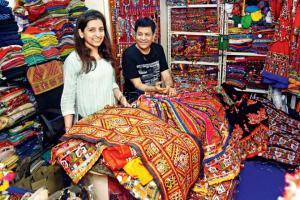While the whole world may line up to buy Kutch embroidery during Navaratri, it's the craft connoisseurs who visit this Matunga store year-round

Pankti Sejpal and her father, Narendra, at their store in Matunga. Pic/Satej Shinde
Narendra Sejpal can read fabrics. The second-generation owner of Gurjar Kutir Udyog, the only store in Mumbai that sells true Kutchi embroidery around the year, can touch an antique fabric and correctly guess its birthplace and age. Thirty-five years ago, he had travelled the dust bowls of Kutch, in Gujarat, and Barmer, in Rajasthan, expanding his knowledge and building relationships with artisans, which continue to hold him in good stead today. "Out of 30 days [in a month], I used to travel for 20 days, collect all the stock and bring it back," he says, in Gujarati.
ADVERTISEMENT
"I used to take a taxi and visit small-small villages. I used to leave at 7 am, and eat [directly] at 10 pm. My room at Prince Hotel [in Bhuj] used to be covered with sand. The contacts we made 30 years ago continue to supply us till today." Kutchi embroidery, the psychedelic blend of hand-embroidery and mirror-work from Kutch, comes in three styles. The most expensive pieces are worn pieces: a woman, usually from the Rabari tribe, would have draped it across her person as a backless choli or ghagra for most of her life. These pieces, just like the women, age beautifully, and are reimagined to create a modern outfit. The second is patches, made-to-order swatches of fabric, in which either the artisan or someone like Narendra comes up with a new design. These are hand-embroidered borders that play supporting roles on cotton kurtis and saris. The third is the machine-made fabrics. At Gurjar, you can get this from '200-400 per metre. They aren't as easy on the eye as the antique pieces, but at least they're easy on the pocket.
A family's woven story
Gurjar Kutir Udyog was started by Maganlal Sejpal, Narendra's father, in 1973. They had migrated from Bagasara, in Gujarat, where they used to run an atelier for beadwork. "We had 300 ladies working for my father," says Narendra. Their first exhibition was held at Aakar Art Gallery in Breach Candy. "We sold so much over there that we were able to establish our shop in Matunga," he says. From a prominent store in Laxmi Narayan Lane, in Matunga Central, they moved to a much smaller space in Chandavarkar Road two years ago.
"The original store has gone to my younger brother now, because we have separated. He stocks only modern handicrafts," says Narendra. "Gurjar is handled only by our family." Even though every member of his family branch, from wife to children, is involved in some way, the face of the store is his soft-spoken daughter, Pankti. "I have been handling things for seven years now," she says. Underneath her patient demeanour, lies a deep reservoir of passion for the crafts of India. "I'm in love with what I do," she says. "I love the heritage of hand-woven and handcrafted things. It's in my blood. It comes from my father and grandfather."
Over the years, the Sejpals have seen a decline in the number of customers. "I used to buy two yards for '28. Today, the value is '2,000," says Narendra. "So, we use small patches now. We use a patch of '800-1000, and attach plain fabric to it." Pankti cites another reason: "Fast fashion. People have started wearing clothes that are cheaper, so that they can get new clothes faster. People who understand will buy; people who don't, won't."
Having said that, the small coterie of customers through the year becomes a heaving crowd during Navaratri. They have stocked 2,000 chaniya-cholis for this season, and welcome nearly 100 customers a day. "We're expecting to sell [them all] one week before Navaratri," says Pankti. We ask her about the outfits available in other stores during Navaratri, and she says, "Those are ready things that are available in Ahmedabad markets. If you go to Ahmedabad, there are three to four markets, where they sell how [stores on] Linking Road do. It's not directly from the artisans; it's from the traders." As someone who has nearly 100 artisans in her phonebook, Pankti, quite rightly, doesn't feel the need to sell any me-toos.
Catch up on all the latest Mumbai news, crime news, current affairs, and also a complete guide on Mumbai from food to things to do and events across the city here. Also download the new mid-day Android and iOS apps to get latest updates
 Subscribe today by clicking the link and stay updated with the latest news!" Click here!
Subscribe today by clicking the link and stay updated with the latest news!" Click here!






